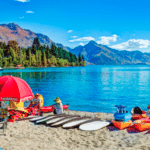Africa, a continent teeming with diverse ecosystems and magnificent wildlife, offers an unparalleled experience for adventure seekers and nature enthusiasts through its renowned safari destinations. From the vast savannahs of the Serengeti to the lush wetlands of the Okavango Delta, each region boasts a unique spectacle of nature.
However, choosing the best time for a safari in Africa can greatly enhance the experience, allowing travelers to witness extraordinary wildlife encounters and breathtaking landscapes. In this article, we delve into the factors that influence the timing of a safari and uncover the secrets of experiencing the ultimate wildlife adventure.

Understanding the Seasons
Africa’s safari destinations experience distinct wet and dry seasons, each offering a different perspective on the wildlife and surroundings. The timing of these seasons can vary depending on the specific region, making it essential to research the area you plan to visit. Generally, there are two primary safari seasons: the Dry Season and the Wet Season.
Dry Season (June to October)
The dry season, often considered the prime time for safaris, stretches from June to October. During these months, many areas experience minimal rainfall, leading to vegetation thinning out and water sources becoming scarcer. This scarcity concentrates wildlife around the remaining waterholes, rivers, and lakes, creating a spectacle of predator-prey interactions that’s a sight to behold.
Iconic destinations like the Serengeti and Maasai Mara host the Great Migration during this period. Millions of wildebeests, zebras, and other herbivores traverse these plains in search of fresh grazing, attracting numerous predators. This spectacle, coupled with the relatively dry landscapes, makes for unparalleled game viewing opportunities.
Wet Season (November to May)
The wet season spans from November to May, varying slightly depending on the region. This period sees increased rainfall, resulting in lush landscapes and abundant vegetation. While the wet season might not offer the same visibility of wildlife as the dry season, it provides a unique chance to witness Africa’s flora in full bloom. Birdwatching enthusiasts will find this season particularly appealing, as migratory birds flock to Africa during this time.
Destinations like Botswana’s Okavango Delta flourish during the wet season. The delta’s intricate network of waterways fills up, transforming the landscape into a breathtaking mosaic of islands and channels. While wildlife might be more dispersed due to the availability of water sources throughout the delta, the vibrant greenery and serene waterscapes are a sight to remember.
Factors to Consider
Wildlife Sightings
The dry season is favored for its exceptional wildlife sightings, as animals congregate around remaining water sources. Travelers keen on witnessing predator-prey interactions and the Great Migration should plan their safari during this time.
Landscape Aesthetics
The wet season offers a lush and vibrant landscape with blooming flora, making it a paradise for photographers and nature lovers. The reflection of greenery in the waterways of destinations like the Okavango Delta creates a picturesque scene.
Crowds and Prices
The dry season’s popularity often results in higher visitor numbers and elevated prices for accommodations and tours. If you prefer a quieter and more budget-friendly experience, the wet season might be a better fit.
Migratory Patterns
Some regions experience unique animal migrations during certain seasons. For example, the wildebeest migration in East Africa occurs primarily during the dry season, while the zebra migration in Botswana’s Makgadikgadi Pans National Park takes place in the wet season.
Specialized Interests
Birdwatchers and botany enthusiasts may prefer the wet season for its diverse bird species and blooming plants. This period provides a chance to appreciate Africa’s avian wonders and rich flora.
Choosing the best time for a safari in Africa requires careful consideration of various factors, including wildlife sightings, weather, and personal preferences. Whether you’re drawn to the drama of predator-prey interactions during the dry season or the lush landscapes and vibrant birdlife of the wet season, Africa’s safari destinations have something to offer year-round.
Each season unveils a different facet of the continent’s natural wonders, promising unforgettable experiences for those willing to explore its diverse ecosystems. Ultimately, the “best” time for a safari depends on what you hope to witness and the type of adventure you seek in the heart of the African wilderness.
Join 25,000+ smart readers—don’t miss out!






